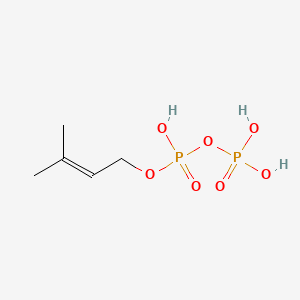| Sun Z et al. |
Can the capacity for isoprene emission acclimate to environmental modifications during autumn senescence in temperate deciduous tree species Populus tremula? |
2012 |
J. Plant Res. |
pmid:21584787
|
| Fu X et al. |
Plastid structure and carotenogenic gene expression in red- and white-fleshed loquat (Eriobotrya japonica) fruits. |
2012 |
J. Exp. Bot. |
pmid:21994170
|
| Green SA et al. |
Identification, functional characterization, and regulation of the enzyme responsible for floral (E)-nerolidol biosynthesis in kiwifruit (Actinidia chinensis). |
2012 |
J. Exp. Bot. |
pmid:22162874
|
| Span I et al. |
Discovery of acetylene hydratase activity of the iron-sulphur protein IspH. |
2012 |
Nat Commun |
pmid:22948824
|
| Bitok JK and Meyers CF |
2C-Methyl-d-erythritol 4-phosphate enhances and sustains cyclodiphosphate synthase IspF activity. |
2012 |
ACS Chem. Biol. |
pmid:22839733
|
| Dozier JK and Distefano MD |
An enzyme-coupled continuous fluorescence assay for farnesyl diphosphate synthases. |
2012 |
Anal. Biochem. |
pmid:22085443
|
| Caballero MC et al. |
Characterization of acyl carrier protein and LytB in Babesia bovis apicoplast. |
2012 |
Mol. Biochem. Parasitol. |
pmid:22057350
|
| Fowler DW et al. |
Mycobacteria activate γδ T-cell anti-tumour responses via cytokines from type 1 myeloid dendritic cells: a mechanism of action for cancer immunotherapy. |
2012 |
Cancer Immunol. Immunother. |
pmid:22002242
|
| Türsen U |
Pathophysiology of the Behçet's Disease. |
2012 |
Patholog Res Int |
pmid:21977335
|
| Thabet I et al. |
Characterization and subcellular localization of geranylgeranyl diphosphate synthase from Catharanthus roseus. |
2012 |
Mol. Biol. Rep. |
pmid:21706164
|
| Emma F et al. |
Renal mitochondrial cytopathies. |
2011 |
Int J Nephrol |
pmid:21811680
|
| Bleeker PM et al. |
RNA-seq discovery, functional characterization, and comparison of sesquiterpene synthases from Solanum lycopersicum and Solanum habrochaites trichomes. |
2011 |
Plant Mol. Biol. |
pmid:21818683
|
| Sun Y et al. |
Pyrosequencing of the Camptotheca acuminata transcriptome reveals putative genes involved in camptothecin biosynthesis and transport. |
2011 |
BMC Genomics |
pmid:22035094
|
| Battilana J et al. |
Functional effect of grapevine 1-deoxy-D-xylulose 5-phosphate synthase substitution K284N on Muscat flavour formation. |
2011 |
J. Exp. Bot. |
pmid:21868399
|
| Zeng Y et al. |
A proteomic analysis of the chromoplasts isolated from sweet orange fruits [Citrus sinensis (L.) Osbeck]. |
2011 |
J. Exp. Bot. |
pmid:21841170
|
| Muraguchi T et al. |
Polished rice as natural sources of cancer-preventing geranylgeranoic acid. |
2011 |
J Clin Biochem Nutr |
pmid:21765600
|
| Hao da C et al. |
The first insight into the tissue specific taxus transcriptome via Illumina second generation sequencing. |
2011 |
PLoS ONE |
pmid:21731678
|
| Okada K |
The biosynthesis of isoprenoids and the mechanisms regulating it in plants. |
2011 |
Biosci. Biotechnol. Biochem. |
pmid:21737944
|
| Schmidt A et al. |
Induction of isoprenyl diphosphate synthases, plant hormones and defense signalling genes correlates with traumatic resin duct formation in Norway spruce (Picea abies). |
2011 |
Plant Mol. Biol. |
pmid:22002747
|
| Jang HJ et al. |
Retinoid production using metabolically engineered Escherichia coli with a two-phase culture system. |
2011 |
Microb. Cell Fact. |
pmid:21801353
|
